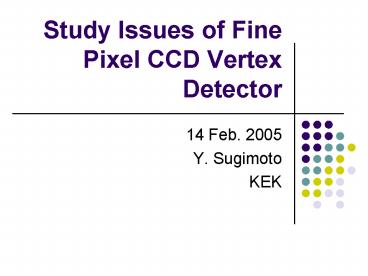Study Issues of Fine Pixel CCD Vertex Detector PowerPoint PPT Presentation
1 / 9
Title: Study Issues of Fine Pixel CCD Vertex Detector
1
Study Issues of Fine Pixel CCD Vertex Detector
- 14 Feb. 2005
- Y. Sugimoto
- KEK
2
Vertex Detector Options
- Many options are proposed for ILC
3
Idea of FPCCD
- Accumulate hit signals for one train and read out
between trains - Keep low pixel occupancy by increasing number of
pixels by x20 with respect to standard pixel
detector - As a result, pixel size should be as small as
5x5mm2 - Epitaxial layer has to be fully depleted to
minimize charge spread by diffusion - Operation at low temperature to keep dark current
negligible (r.o. cycle200ms)
4
Challenges of FPCCD
- Pixel size
- Tracking efficiency
- Thin wafer and support structure
- Lorentz angle
- Low B is preferable
- Readout electronics
- Signal level is small (500 e)
- Radiation hardness
- Relaxed by low temp. operation
5
Study Issues
- Long term goal (by TDR)
- Fabrication of prototype ladders
- Test the prototypes and demonstrate the
performance - Mid term goal (by the Detector outline
document) - Simulation study
- Tracking efficiency
- Physics implication (Flavor tagging)
- Hardware study (depends on funding)
- Charge spread in fully depleted CCDs
- Lorentz angle in B field ? Optimization of wafer
tilt angle - Radiation hardness (difference in fully depleted
CCD?) - Show that FPCCD works as a vertex detector in
principle
6
Study of Tracking Efficiency
- In FPCCD, pixel occupancy would be low (lt1) but
hit density mainly due to the pair-background is
as high as 40/mm2 (B3T, R20mm) - So, whether we can get good tracking efficiency
or not is not trivial - Extrapolation of tracks from Si intermediate
tracker with bunch ID capability will be
necessary - The study of tracking efficiency under high
background rate is the most important and urgent
issue - Simulation framework to overlap background hits
with physics events has to be constructed
7
Some ideas for b.g. rejection
- B.G. rejection by hit cluster shape
- (tracking capability with single layer!)
- Standard CCD
- Fine Pixel CCD
8
Some ideas for b.g. rejection
- CCD doublet in proximity to reduce effect of M.S.
9
Schedule
LCWS05
Snowmass
Vertex05
Detector Outline Document
ACFA8
LCWS06
Simulation w/o b.g
Tracking Eff. sim.
B.G. overlap f.w.
Flavor Tag. Sim.
Charge spread in CCD
Lorentz angle study
Design of prototype
Radiation hardness

